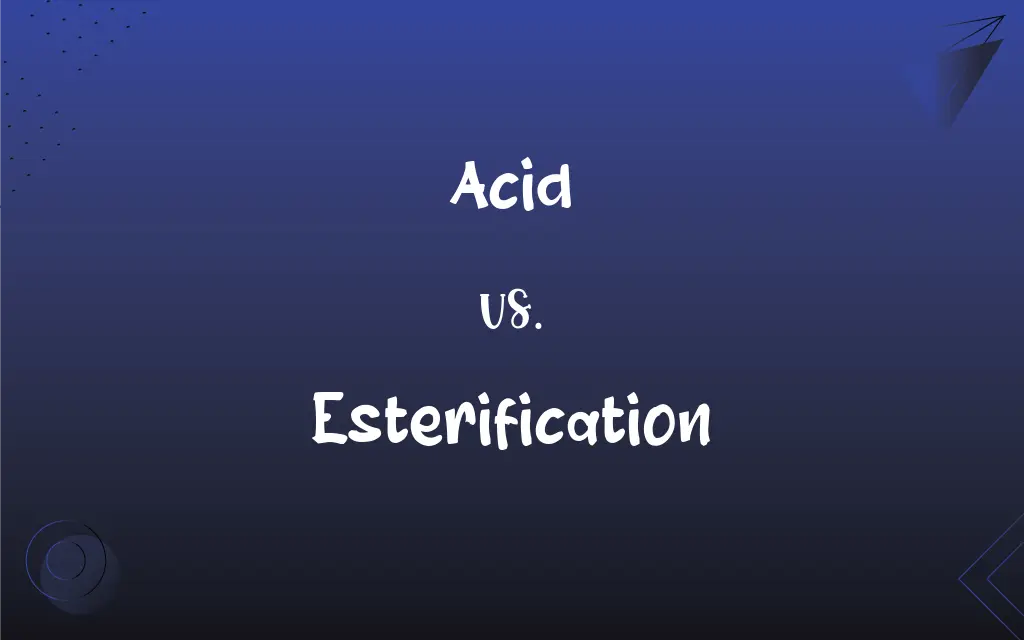Acid vs. Esterification: What's the Difference?
Edited by Aimie Carlson || By Janet White || Updated on November 10, 2023
An acid is a substance that donates protons or accepts electrons, while esterification is a chemical reaction where an acid reacts with an alcohol to form an ester.

Key Differences
Acids are chemical compounds that can donate hydrogen ions or accept electron pairs, typically having a pH less than 7. Esterification, on the other hand, is a specific chemical process where acids react with alcohols to form esters, often involving the elimination of water.
The nature of acids varies widely, from strong mineral acids like sulfuric acid to weak organic acids like acetic acid. In esterification, an acid (often an organic acid) combines with an alcohol, a process catalyzed by an acid catalyst.
Acids have distinct properties like sour taste, ability to turn blue litmus paper red, and corrosive nature. Esterification results in the formation of esters, which are characterized by their pleasant fragrances and are used in flavors and perfumes.
The study of acids is crucial in understanding various chemical reactions and pH balance in different environments. Esterification is important in industrial chemistry, particularly in the synthesis of polymers and various organic compounds.
In biochemistry, acids like amino acids play a vital role in life processes. Esterification can also occur naturally, as in the synthesis of fats and biological waxes.
ADVERTISEMENT
Comparison Chart
Definition
Substance that donates protons/accepts electrons
Reaction between acid and alcohol to form ester
Chemical Properties
PH less than 7, sour taste, corrosiveness
Formation of esters, often with water removal
Types/Examples
Sulfuric acid, acetic acid
Esterification of acetic acid and ethanol
Role in Chemistry
Fundamental in chemical reactions, pH balance
Important in industrial synthesis, fragrances
Biological Significance
Amino acids in biochemistry
Natural synthesis of fats and biological waxes
ADVERTISEMENT
Acid and Esterification Definitions
Acid
Has a pH less than 7.
Lemon juice is acidic due to citric acid.
Esterification
Used in the synthesis of flavors and fragrances.
Esterification is used to create artificial fruit flavors.
Acid
Turns blue litmus paper red.
Vinegar, containing acetic acid, turns litmus paper red.
Esterification
Often involves elimination of water.
Esterification typically releases water as a byproduct.
Acid
Substance that donates hydrogen ions.
Hydrochloric acid is a strong acid used in industry.
Esterification
Chemical reaction forming esters from acids and alcohols.
Esterification of acetic acid with ethanol produces ethyl acetate.
Acid
Can accept electron pairs.
Sulfuric acid accepts electron pairs in reactions.
Esterification
Catalyzed by acid catalysts.
Sulfuric acid can catalyze esterification reactions.
Acid
Often corrosive and sour in taste.
Battery acid is corrosive and dangerous.
Esterification
Important in industrial and organic chemistry.
Esterification is key in producing certain plastics and polymers.
Acid
Any of a class of substances whose aqueous solutions are characterized by a sour taste, the ability to turn blue litmus red, and the ability to react with bases and certain metals to form salts.
Esterification
A chemical reaction resulting in the formation of at least one ester product.
Acid
A substance that yields hydrogen ions when dissolved in water.
FAQs
Are all acids corrosive?
Strong acids are corrosive, but weak acids are less so.
Can acids be weak?
Yes, organic acids like acetic acid are typically weak.
What defines an acid?
An acid is a substance that can donate hydrogen ions.
What is esterification?
Esterification is a reaction where an acid and an alcohol form an ester.
Do acids always have a sour taste?
Most acids have a sour taste, like citric acid in lemons.
What catalysts are used in esterification?
Acid catalysts like sulfuric acid are commonly used.
Is esterification reversible?
Yes, esterification can be reversed under certain conditions.
Can esterification occur naturally?
Yes, esterification can occur naturally in biological processes.
What's the outcome of esterification?
Esterification produces esters and often releases water.
Can acids be part of foods?
Yes, many foods contain natural acids like citric acid in fruits.
How do acids react with metals?
Acids can react with metals to produce hydrogen gas.
Is vinegar an acid?
Yes, vinegar contains acetic acid.
Are all esterification reactions the same?
The basic process is similar, but reactants and conditions can vary.
Are acids dangerous?
Strong acids can be hazardous, but weak acids are generally safer.
What products are made by esterification?
Esterification produces esters used in various industrial products.
What role does esterification play in biochemistry?
Esterification is involved in synthesizing fats and biological waxes.
What is the pH range of acids?
Acids have a pH less than 7.
Are esters always fragrant?
Many esters have pleasant fragrances but not all.
What's the industrial use of esterification?
Esterification is used in making plastics, fragrances, and flavors.
Can acids conduct electricity?
Yes, acids can conduct electricity when dissolved in water.
About Author
Written by
Janet WhiteJanet White has been an esteemed writer and blogger for Difference Wiki. Holding a Master's degree in Science and Medical Journalism from the prestigious Boston University, she has consistently demonstrated her expertise and passion for her field. When she's not immersed in her work, Janet relishes her time exercising, delving into a good book, and cherishing moments with friends and family.
Edited by
Aimie CarlsonAimie Carlson, holding a master's degree in English literature, is a fervent English language enthusiast. She lends her writing talents to Difference Wiki, a prominent website that specializes in comparisons, offering readers insightful analyses that both captivate and inform.































































